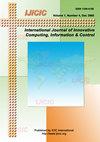Classification of Attention Deficit Hyperactivity Disorder using Variational Autoencoder
IF 1.1
Q4 COMPUTER SCIENCE, ARTIFICIAL INTELLIGENCE
International Journal of Innovative Computing Information and Control
Pub Date : 2021-10-31
DOI:10.11113/ijic.v11n2.352
引用次数: 0
Abstract
Attention Deficit Hyperactivity Disorder (ADHD) categorize as one of the typical neurodevelopmental and mental disorders. Over the years, researchers have identified ADHD as a complicated disorder since it is not directly tested with a standard medical test such as a blood or urine test on the early-stage diagnosis. Apart from the physical symptoms of ADHD, clinical data of ADHD patients show that most of them have learning problems. Therefore, functional Magnetic Resonance Imaging (fMRI) is considered the most suitable method to determine functional activity in the brain region to understand brain disorders of ADHD. One of the ways to diagnose ADHD is by using deep learning techniques, which can increase the accuracy of predicting ADHD using the fMRI dataset. Past attempts of classifying ADHD based on functional connectivity coefficient using the Deep Neural Network (DNN) result in 95% accuracy. As Variational Autoencoder (VAE) is the most popular in extracting high-level data, this model is applied in this study. This study aims to enhance the performance of VAE to increase the accuracy in classifying ADHD using fMRI data based on functional connectivity analysis. The preprocessed fMRI dataset is used for decomposition to find the region of interest (ROI), followed by Independent Component Analysis (ICA) that calculates the correlation between brain regions and creates functional connectivity matrices for each subject. As a result, the VAE model achieved an accuracy of 75% on classifying ADHD.变分自编码器对注意缺陷多动障碍的分类
注意缺陷多动障碍(ADHD)是一种典型的神经发育障碍和精神障碍。多年来,研究人员已经确定ADHD是一种复杂的疾病,因为它不能直接通过早期诊断的标准医学测试(如血液或尿液测试)进行测试。ADHD患者的临床资料显示,除了身体上的症状外,大多数ADHD患者都有学习问题。因此,功能性磁共振成像(fMRI)被认为是最合适的方法来确定大脑区域的功能活动,以了解多动症的脑部疾病。诊断ADHD的方法之一是使用深度学习技术,这可以提高使用功能磁共振成像数据集预测ADHD的准确性。过去使用深度神经网络(Deep Neural Network, DNN)基于功能连接系数对ADHD进行分类的尝试准确率为95%。由于变分自编码器(VAE)在高阶数据提取中应用最为广泛,本研究采用了该模型。本研究旨在增强VAE的性能,以提高基于功能连通性分析的fMRI数据对ADHD分类的准确性。预处理的fMRI数据集用于分解以找到感兴趣的区域(ROI),然后进行独立成分分析(ICA),计算大脑区域之间的相关性并为每个受试者创建功能连接矩阵。结果,VAE模型对ADHD的分类准确率达到75%。
本文章由计算机程序翻译,如有差异,请以英文原文为准。
求助全文
约1分钟内获得全文
求助全文
来源期刊
CiteScore
3.20
自引率
20.00%
发文量
0
审稿时长
4.3 months
期刊介绍:
The primary aim of the International Journal of Innovative Computing, Information and Control (IJICIC) is to publish high-quality papers of new developments and trends, novel techniques and approaches, innovative methodologies and technologies on the theory and applications of intelligent systems, information and control. The IJICIC is a peer-reviewed English language journal and is published bimonthly

 求助内容:
求助内容: 应助结果提醒方式:
应助结果提醒方式:


